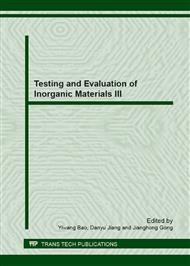p.281
p.286
p.291
p.295
p.299
p.304
p.310
p.316
p.321
Effects on Cold Modulus of Rupture and Cold Crushing Strength of One Low Cement Refractory Castable (LCRC)
Abstract:
Cement addition, water addition and wet curing period are selected as the effects on cold modulus of rupture and cold crushing strength of one LCRC. According to the molding morphologies of the castables, when the water addition is 8 wt. %, the castable is suitable to be cast by vibration fashion, and the high strength of the castable can be kept because the hardening time is not very long. Through an orthogonal experiment, it is shown that cold modulus of rupture and cold crushing strength increase with increasing cement addition, decrease with increasing water addition, almost do not affect by the wet curing period. It is recommended that 4 wt. % cement addition and 8 wt. % water addition of the castable are used when it is applied to industries.
Info:
Periodical:
Pages:
299-303
Citation:
Online since:
March 2013
Authors:
Price:
Сopyright:
© 2013 Trans Tech Publications Ltd. All Rights Reserved
Share:
Citation:


